Luang Prabang
Monday, December 12. In the last post, I mentioned that the hotel we were staying at, in Luang Prabang, used to be the former prince’s villa. Yesterday we went touring and saw the royal palace itself. Outside was a bronze statue of the last king, donated by the Soviets. He was sporting a Stalin-style haircut.
The guide was very proud of the palace’s grandeur. Indications are that the people involved with it are, as well. In any case, they are very protective of it. You can’t take anything inside, not even a sketch pad, never mind a camera. Leave your shoes at the door.
We walked past a gramophone and a big console hifi, and into the grand hall, where the walls were covered by scores of small, individual Japanese glass mosaics cover the walls, each about the size of my hand, each about a hand-span from each other. To me, the most impressive thing about it was a reception room whose walls were covered with oil paintings by French and Lao artists in a style that was heavily reminiscent of Henri Rousseau. They depicted various facets of Lao life in the middle of the 20th Century in a beautiful and loving style. I would have really liked to buy some postcards of these paintings. I would have even sprung for an overpriced book of them. No luck: no pictures were allowed, so no postcards!
A separate building, the size of many of the largest wats in town, was built by the crown prince to house the funeral carriage for the last king. Not to be disrespectful, but to give you an idea, it was the size of a Macy’s Day float. On it were huge urns for housing the remains of the king and his wife. I notice that it sat on four truck tires. Our guide said it was used to carry the king’s casket to the crematorium, drawn by elephants. That must have been a stirring site.
‘Would you like to see the king’s limousine? It’s a Lincoln!’ said our guide. Ah, thanks but no. Mary searched on line later. It’s white, also very big.
Wats
We declined traveling to some temples, but we did visit a couple nearby. The most impressive one in the city is Wat Xieng Thong. I don’t think photos can do it justice, as its buildings are covered with sparkling mosaics, and the decorative carvings (dragons?) on the corners of the roofs were gleaming with glass tiles. This was the royal Wat, and our guide’s home for a number of years, when he was a monk. He was grateful and proud that US ambassador gave $650K for its renovation.
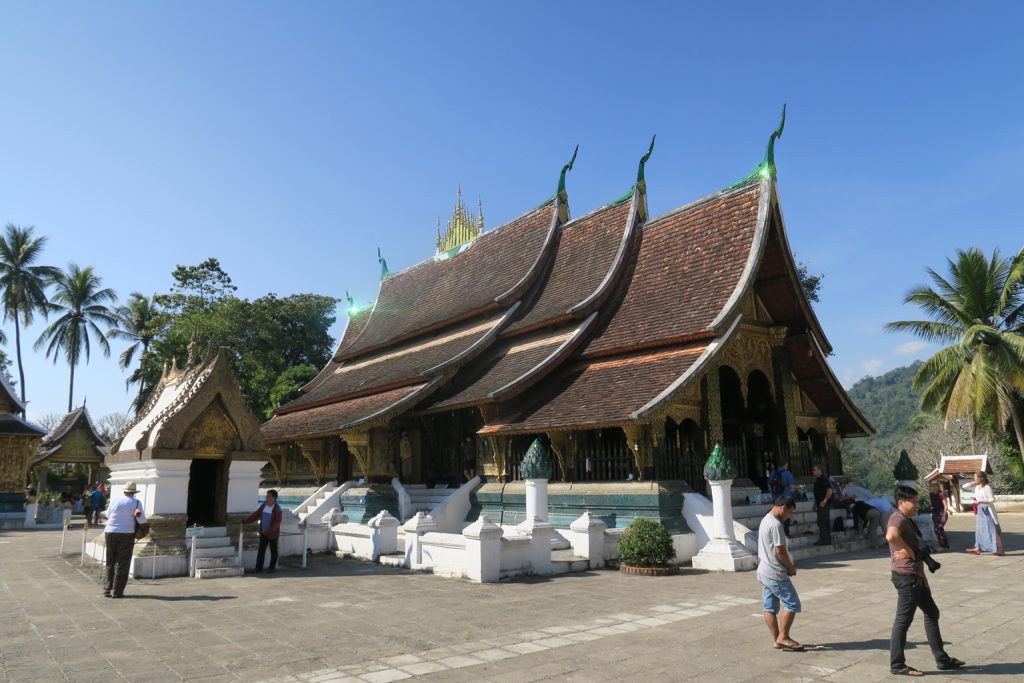
If we let him, I think our guide would have taken us to temple after temple. He loved them, and loved knowing a lot about them. It seems there are various styles of temples, or should I say temple complexes. Most have three buildings: a central place to pray, with the biggest buddha statue; a dormitory for the monks; a stupa, or tomb.
Books about Luang Prabang also seem to concentrate on its temples. Ones that I looked at — trying to find more information about those paintings I admired, and maybe some pictures of them — offered little or no information about the palace, compared to the various temples.
Monks and Monastic Life
Why this deep interest in temples? Also, why are there So Many monks, and how is it that the Lao are so committed to supporting them?
Well, like both our guides in Laos, most every boy becomes one, so it’s no surprise to me that people are happy to support them. Once a boy becomes a monk, he can quit at any time; no penalty. We’re told only about 2% of men who become monks actually stay with it their whole lives. Some city kids only become monks for a few days, commonly as a tribute to a loved one’s passing. Others, though, particularly boys from poor families or from the hills, where there’s no real opportunity to get an education, become monks for two to four years. There the boys get an education and an opportunity to become part of mainstream life. They learn the Lao language (more on that later), probably some English as well. They also learn the normal things we see in school — mathematics, history, and so on — and a skill, electronics for example. They are taught Buddha’s precepts, but not only morals, but the bigger picture, ie, the cultural norms of their society.
Here’s an example: In the mountain villages, which can be remote from each other, there is commonly an annual festival whose function is at least partly to introduce young men and women, with the idea of marriage. The specifics vary, but the pattern is that the girl throws something to a boy she fancies, a ball, say. If he likes her, he’ll catch it and bring it to her. Obviously this will not wash in even a town of Luang Prabang, and both our guides found their wives in more urbane ways.
When I say remote, I mean it. In order to get to his home village, one of our guides had to take a bus for four hours, then walk for five! Also, the language of each mountain tribe is different, and they don’t speak Lao in their villages. Life there is hardscrabble. It means subsistence farming, hunting and gathering. In order to better themselves, I can’t see a better opportunity for a boy in one of these villages to get out of it than to become a monk for a while, get an education, learn Lao, learn a skill.
Here some monks have gone out to fix one of the bamboo bridges that cross the Nam Khan River with a mat of bamboo.
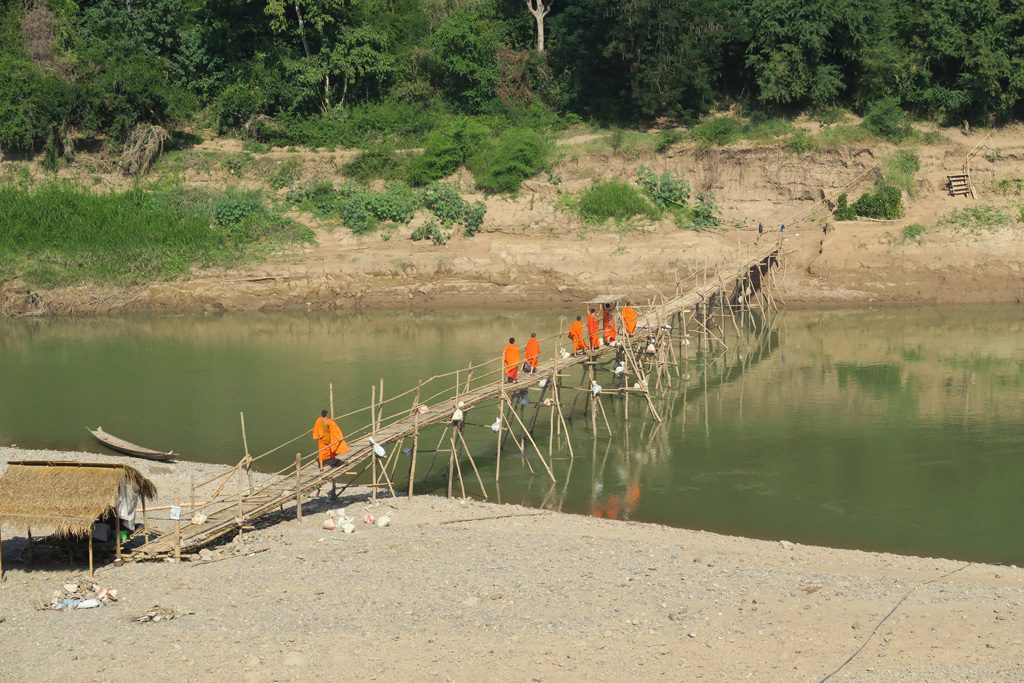
The next day it becomes apparent to us that they need to study engineering a bit more.

Still, now I can understand the interest in supporting the monks and temples. I’d still like pictures from inside that palace, though.
Ethnology Museum
We were also taken to a private, non-profit ethnology museum yesterday. This was manned by people who reminded me of missionaries, with their enthusiasm. I have the impression they believe they are responding to a higher calling. They are dismayed that the villagers and tribal people are less interested in their traditions, that they dress up in their costumes only on special occasions, in favor of more modern dress. They also think it is important to support and continue these traditions.
I see the same thing in my mother’s home town, in the Czech Republic. The old costumes are stunning. It’s fun to see the pretty girls and handsome boys in them during festival times. But $2,000 for a pair of those boots? And that’s only the beginning.
Similarly here in Laos. Heavy silver headdresses and fine silks are impressive, but the cost of them would probably go a long way to making their lives easier. Silver headdress, motorized roto-tiller? Not being in their shoes, I don’t know what I would choose.
The other day I received an offer: “Why spend tedious hours writing your blog. Check out the Digital ____ ____ to automatically create content!” Um . . . What do you think I should do?
Kuang Si Waterfalls
Monday, the 12th. Today we went to see the Kuang Si waterfalls. Beautiful. Much easier to understand. I found a very comfortable spot and tried my hand at plein air watercolor of the main waterfall. Once I’m satisfied with the watercolor, I’ll post it in addition to this photo.
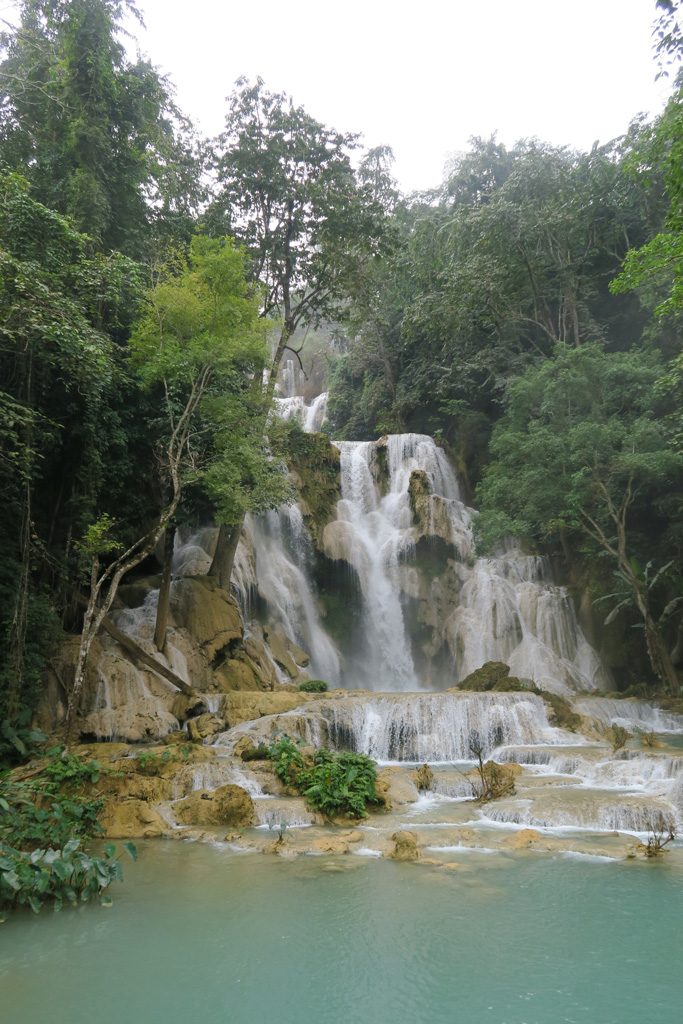
The water is an incredible blue color, and they allow swimming in one of the pools.
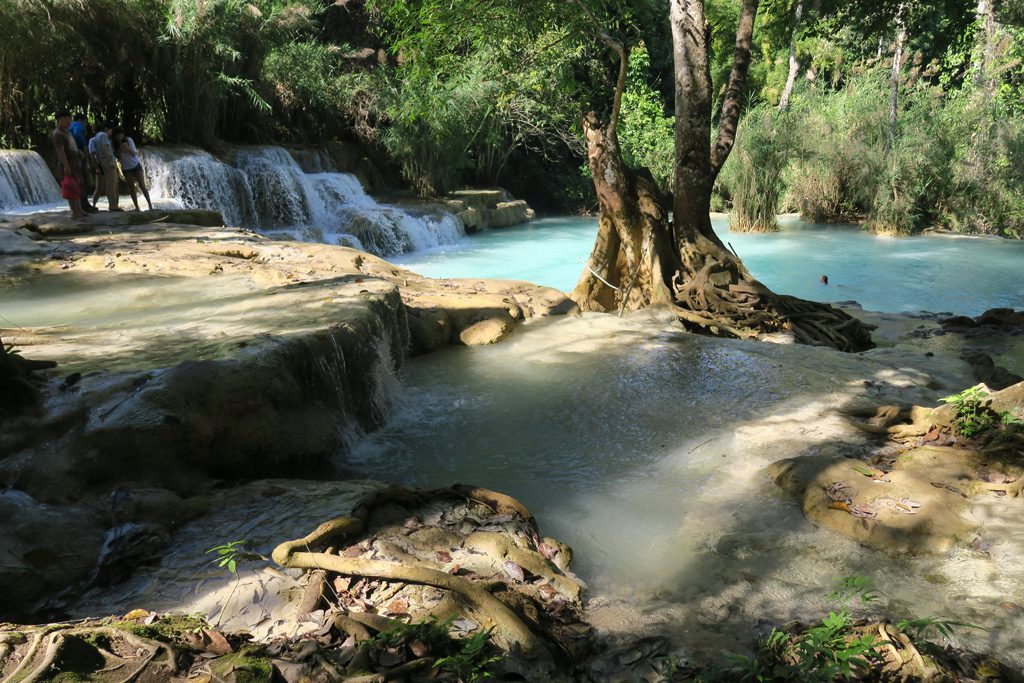
A lot of people climb one of the hills here to see the sunset from the highest temple. We try to avoid crowds.
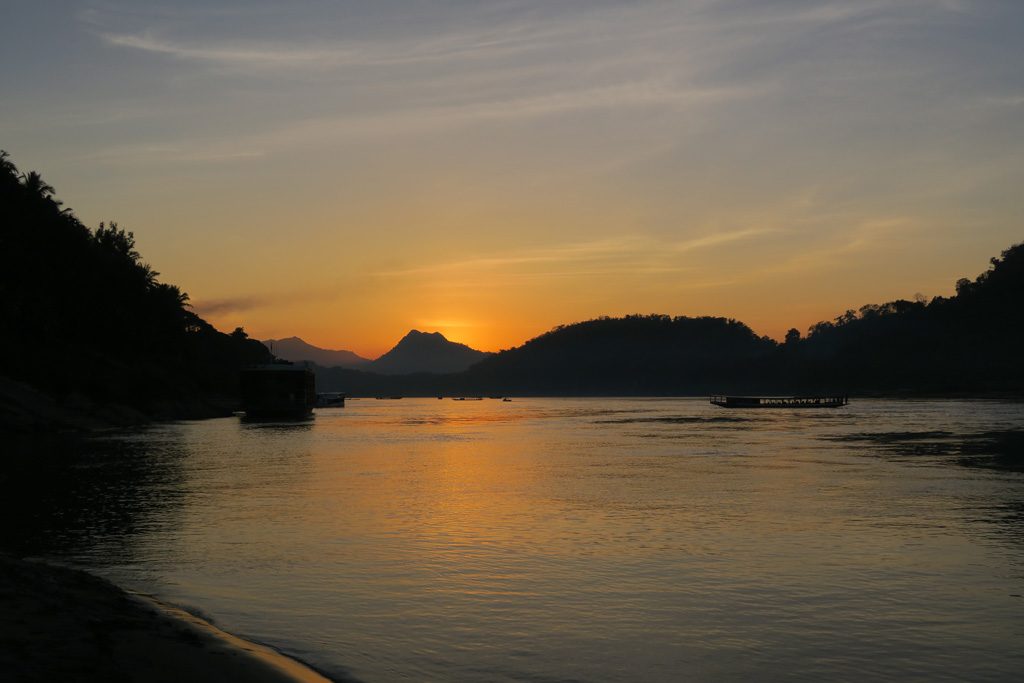
Tuesday, the 13th, early morning
We need to catch a ride to the airport no later than 7:00AM for a flight to Hanoi. I got up at 5:15 like a lot of tourists in town, to see the monks come through town for alms. We were supposed to do this yesterday, but we weren’t really that interested, and today we had to get up early anyway, so I figured I’d go see what all the fuss is about.
There is a monastery near the hotel, but the man at the front desk told me that a better place to see this alms-giving is 15 minutes up the road. I’m used to walking in NYC, so I made it in 10. The walk itself is interesting, with sights, sounds and smells.
It was just before sunrise when I set out, so it was dark, and the streetlights along the main street were not lit. As I left the hotel, I smelled the woodsmoke of cooking fires, then bread baking. At one point, though, as in many places in Asia, there was a smell of sewage. I got a kick out of one rooster. Most of them call out “Rr’-ee-r’-õõ__.” This guy was the Henny Youngman of roosters. He had great comic timing: “Rr’-ee-r’ . . . R!”
Here and there along the street there were people sitting on rugs on the sidewalks or on low little stools, so as not to be above the monks, I suppose. They had baskets containing packages of food. Where I was heading had a concentration of these folks, lines of them. Many of these were tourists, who had arranged — through their hotels, perhaps — to have similar baskets of stuff to give the monks.
Among the Lao, it was business as usual. Some had a sort of scarf draped over one shoulder, but others just sat there patiently waiting to distribute what they brought. For the tourists it was party time: chatting, laughing, lots of selfie sticks. Others of us were standing in the periphery, cameras at the ready.
Our guide is not really in favor of the tourists giving alms to the monks, particularly food. He says it’s not our business or belief, so it’s kind of patronizing. It’s also not sanitary. We were puzzled by this last remark until we talked to one of our fellow tourists who excitedly told us how she would pinch off bits of sticky rice and put them into the bowls of the young monks as they passed by.
So here it is, folks:
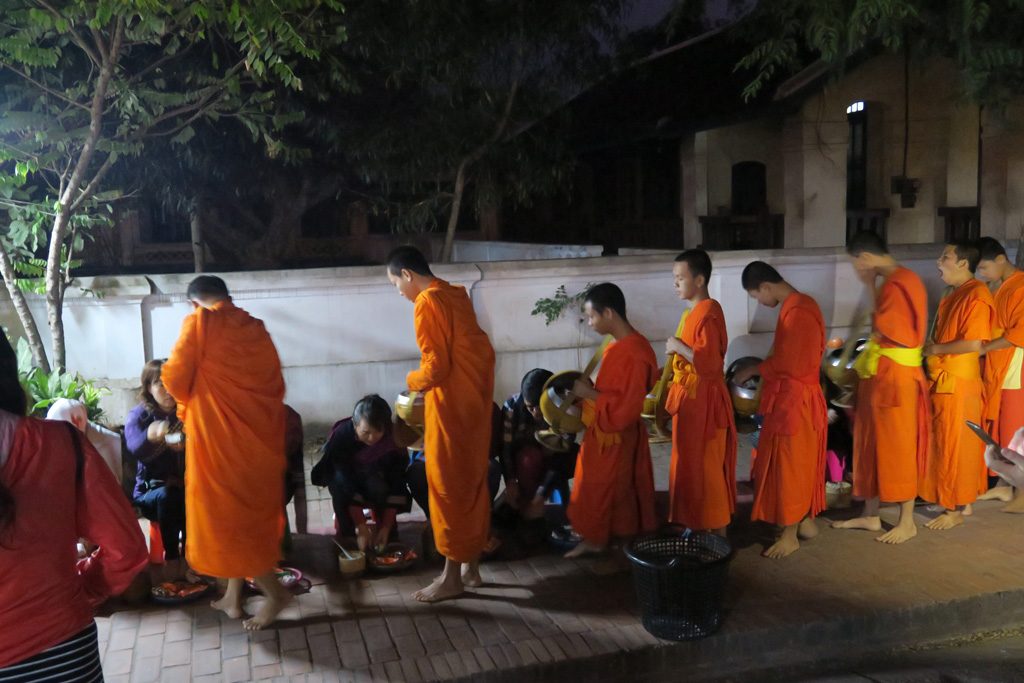
Compare and Contrast
I’m still working on to understanding Southeast Asia. So I thought I’d try to compare Luang Prabang to an American town.
Mary and I moved from New York City to a North Carolina town about 500 miles South. The town is only half Luang Prabang’s size. Still it is a county seat, like Luang Prabang, and has to be easier to compare to it than, say New York City.
Luang Prabang is a UNESCO World Heritage site; our town is on the National Register. They get international support; our main historic attraction, which we call The Governor’s Palace, is now mainly a desirable place to hold a wedding reception.
We look around and see people getting by, and some that don’t seem to be well off at all. Wikipedia calls our part of the state ‘impoverished, with close to 21% of the population below the poverty line.’
Tourism is the main business of Luang Prabang, and agriculture is important in the area. Luang Prabang is well situated, where the Nam Khan River meets the Mekong, and boasts a number of beautiful and interesting temples as well as the king’s palace. Tourism also supports an active handicraft business. Every night, the town hosts a night market, closing off a quarter mile or so of the main street.
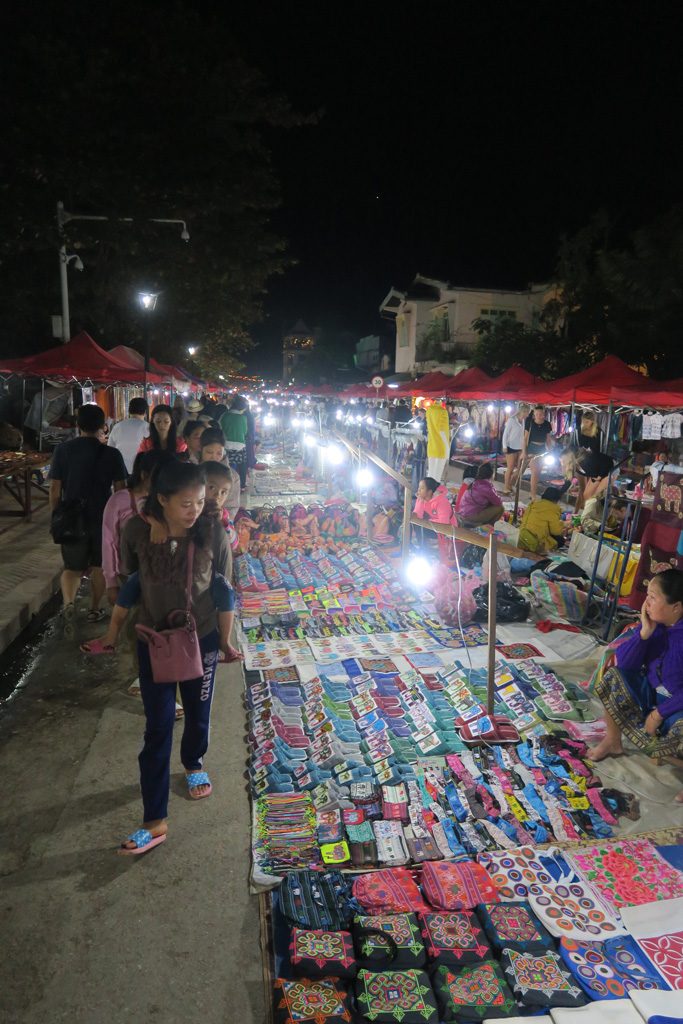
Our town’s economy relies mostly on agriculture, the defense industry, and manufacturing. There is always a scattering of tourists around town, interested in its place in history, and the town is pretty, at the confluence of the Neuse and Trent Rivers. On a number of occasions each year there are festivals that draw people from miles around to our town, for example Mum Fest, in the Fall. Last year our house was on the Kitchen Tour, supporting the local soup kitchen.
So far, similarities line up.
On Constitution Day people in Laos fly their national flag and the party flag. In our town, people put out bunting on national holidays, as well as flying the US flag, though one of our neighbors flies the Confederate flag instead of the Stars and Stripes.
And here is one difference that is striking: A young man in Southeast Asia who does not have a lot of money but wants to better himself joins a monastery to get an education. In the US he would join the military.
Next stop, Hanoi
